Queensland University: IAB204 Little Stars Business Analysis Report
VerifiedAdded on 2023/01/16
|15
|2696
|37
Report
AI Summary
This report presents a business analysis of Little Stars, a preschool educational facility, addressing the need for an automated information system. The analysis begins with an executive summary and table of contents, followed by an introduction outlining the report's purpose, goals, and objectives. A needs assessment is conducted, encompassing a problem statement, SWOT analysis, stakeholder analysis, root cause analysis, and capability analysis to identify gaps in the current system. The report then details the requirements elicitation process, including the elicitation plan, information requirements preparation, meeting plan, data collection techniques, and the creation of an As-Is process model. Business requirements are defined through use cases and user stories. The subsequent requirements analysis section documents and analyzes the gathered information, including use case diagrams, activity flow diagrams, and prioritized solution requirements, encompassing business, stakeholder, functional, non-functional, and transition requirements, as well as a requirement traceability matrix. The report concludes with a summary of the findings and references to the sources used.
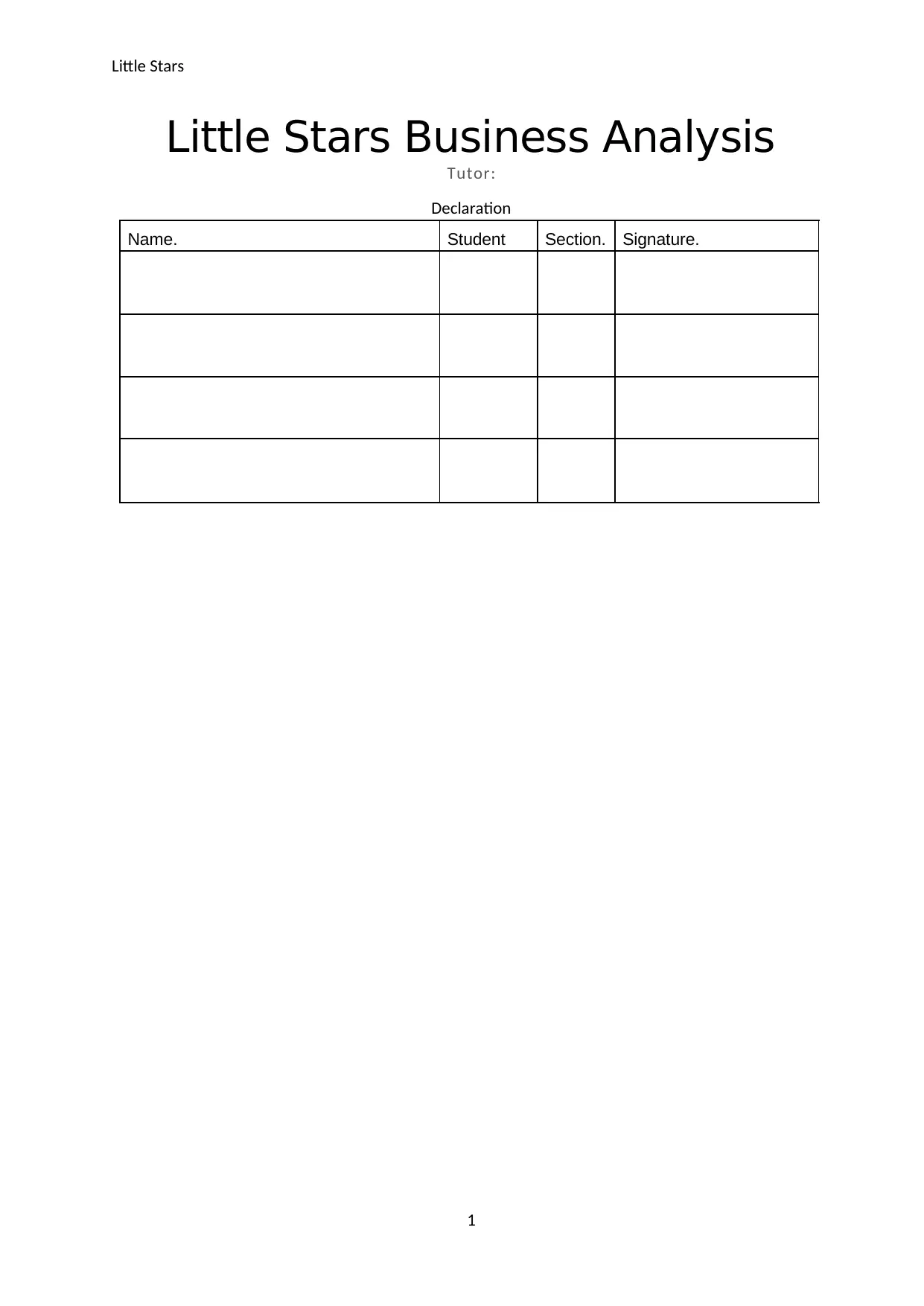
Little Stars
Little Stars Business Analysis
Tutor:
Declaration
Name. Student
No.
Section. Signature.
1
Little Stars Business Analysis
Tutor:
Declaration
Name. Student
No.
Section. Signature.
1
Paraphrase This Document
Need a fresh take? Get an instant paraphrase of this document with our AI Paraphraser
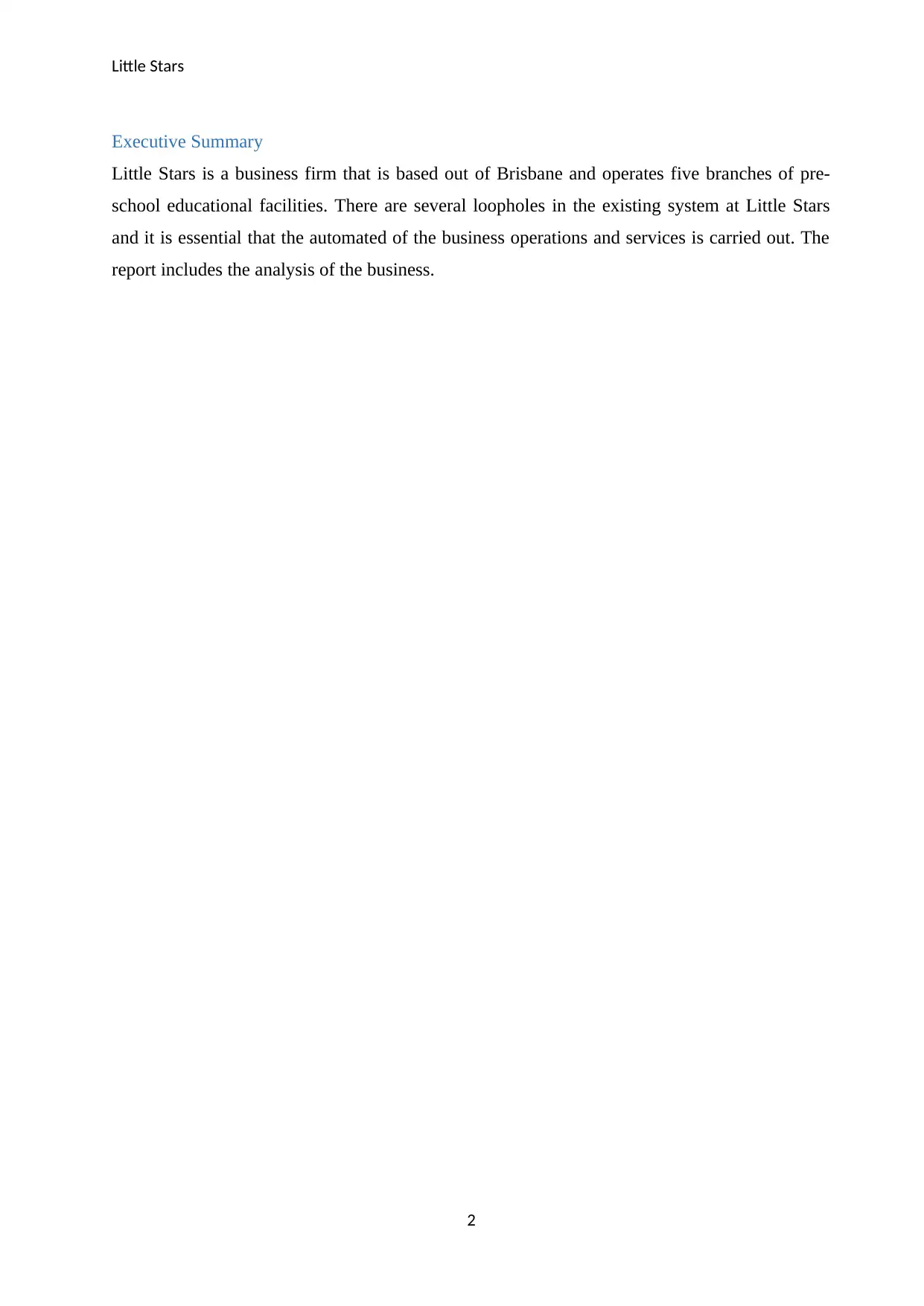
Little Stars
Executive Summary
Little Stars is a business firm that is based out of Brisbane and operates five branches of pre-
school educational facilities. There are several loopholes in the existing system at Little Stars
and it is essential that the automated of the business operations and services is carried out. The
report includes the analysis of the business.
2
Executive Summary
Little Stars is a business firm that is based out of Brisbane and operates five branches of pre-
school educational facilities. There are several loopholes in the existing system at Little Stars
and it is essential that the automated of the business operations and services is carried out. The
report includes the analysis of the business.
2
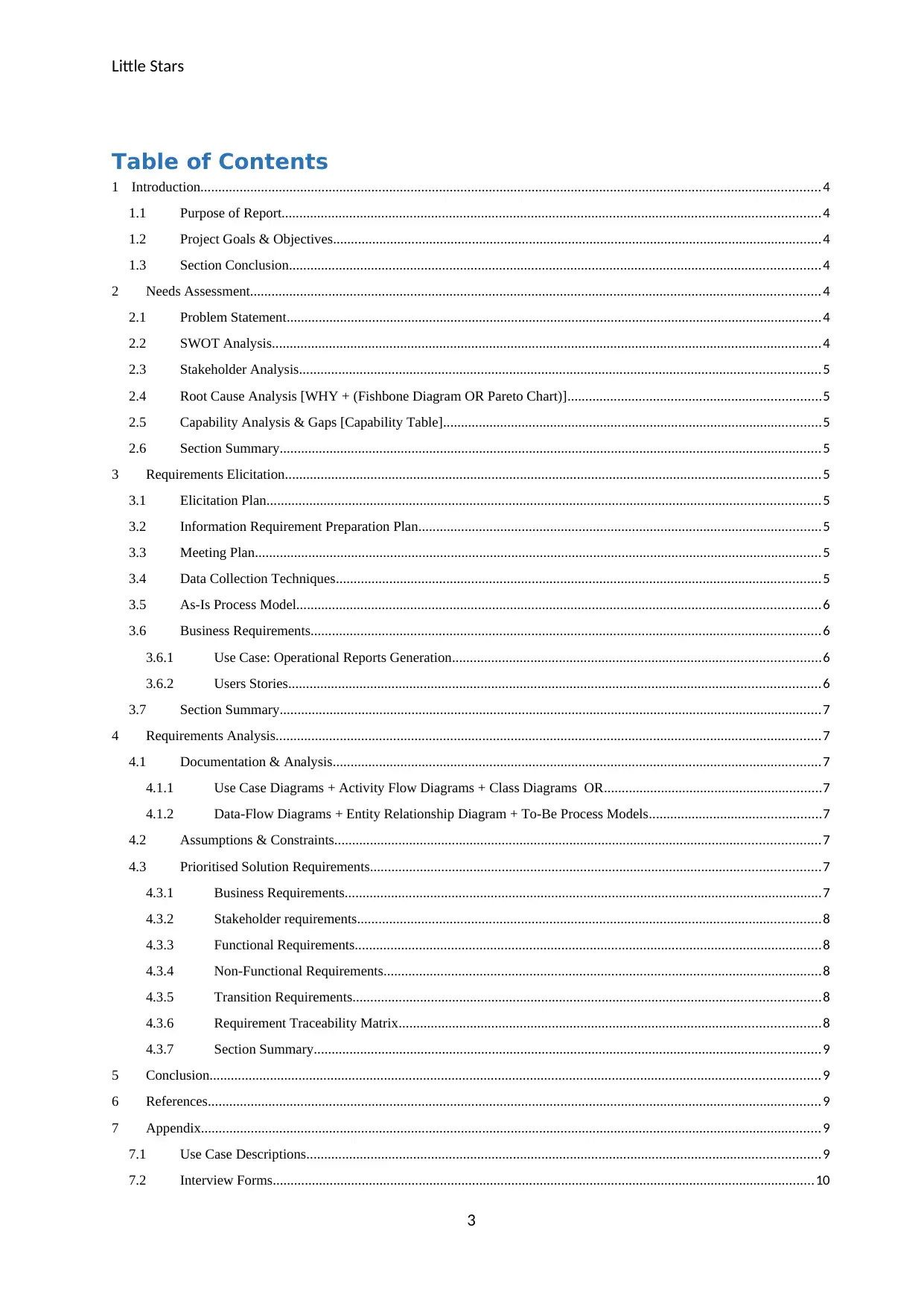
Little Stars
Table of Contents
1 Introduction.............................................................................................................................................................................. 4
1.1 Purpose of Report.......................................................................................................................................................4
1.2 Project Goals & Objectives.........................................................................................................................................4
1.3 Section Conclusion.....................................................................................................................................................4
2 Needs Assessment................................................................................................................................................................ 4
2.1 Problem Statement......................................................................................................................................................4
2.2 SWOT Analysis..........................................................................................................................................................4
2.3 Stakeholder Analysis..................................................................................................................................................5
2.4 Root Cause Analysis [WHY + (Fishbone Diagram OR Pareto Chart)].......................................................................5
2.5 Capability Analysis & Gaps [Capability Table]..........................................................................................................5
2.6 Section Summary........................................................................................................................................................5
3 Requirements Elicitation......................................................................................................................................................5
3.1 Elicitation Plan........................................................................................................................................................... 5
3.2 Information Requirement Preparation Plan.................................................................................................................5
3.3 Meeting Plan............................................................................................................................................................... 5
3.4 Data Collection Techniques........................................................................................................................................5
3.5 As-Is Process Model...................................................................................................................................................6
3.6 Business Requirements...............................................................................................................................................6
3.6.1 Use Case: Operational Reports Generation.......................................................................................................6
3.6.2 Users Stories.....................................................................................................................................................6
3.7 Section Summary........................................................................................................................................................7
4 Requirements Analysis.........................................................................................................................................................7
4.1 Documentation & Analysis.........................................................................................................................................7
4.1.1 Use Case Diagrams + Activity Flow Diagrams + Class Diagrams OR.............................................................7
4.1.2 Data-Flow Diagrams + Entity Relationship Diagram + To-Be Process Models................................................7
4.2 Assumptions & Constraints........................................................................................................................................7
4.3 Prioritised Solution Requirements..............................................................................................................................7
4.3.1 Business Requirements......................................................................................................................................7
4.3.2 Stakeholder requirements..................................................................................................................................8
4.3.3 Functional Requirements...................................................................................................................................8
4.3.4 Non-Functional Requirements...........................................................................................................................8
4.3.5 Transition Requirements...................................................................................................................................8
4.3.6 Requirement Traceability Matrix......................................................................................................................8
4.3.7 Section Summary..............................................................................................................................................9
5 Conclusion........................................................................................................................................................................... 9
6 References............................................................................................................................................................................ 9
7 Appendix.............................................................................................................................................................................. 9
7.1 Use Case Descriptions................................................................................................................................................9
7.2 Interview Forms........................................................................................................................................................10
3
Table of Contents
1 Introduction.............................................................................................................................................................................. 4
1.1 Purpose of Report.......................................................................................................................................................4
1.2 Project Goals & Objectives.........................................................................................................................................4
1.3 Section Conclusion.....................................................................................................................................................4
2 Needs Assessment................................................................................................................................................................ 4
2.1 Problem Statement......................................................................................................................................................4
2.2 SWOT Analysis..........................................................................................................................................................4
2.3 Stakeholder Analysis..................................................................................................................................................5
2.4 Root Cause Analysis [WHY + (Fishbone Diagram OR Pareto Chart)].......................................................................5
2.5 Capability Analysis & Gaps [Capability Table]..........................................................................................................5
2.6 Section Summary........................................................................................................................................................5
3 Requirements Elicitation......................................................................................................................................................5
3.1 Elicitation Plan........................................................................................................................................................... 5
3.2 Information Requirement Preparation Plan.................................................................................................................5
3.3 Meeting Plan............................................................................................................................................................... 5
3.4 Data Collection Techniques........................................................................................................................................5
3.5 As-Is Process Model...................................................................................................................................................6
3.6 Business Requirements...............................................................................................................................................6
3.6.1 Use Case: Operational Reports Generation.......................................................................................................6
3.6.2 Users Stories.....................................................................................................................................................6
3.7 Section Summary........................................................................................................................................................7
4 Requirements Analysis.........................................................................................................................................................7
4.1 Documentation & Analysis.........................................................................................................................................7
4.1.1 Use Case Diagrams + Activity Flow Diagrams + Class Diagrams OR.............................................................7
4.1.2 Data-Flow Diagrams + Entity Relationship Diagram + To-Be Process Models................................................7
4.2 Assumptions & Constraints........................................................................................................................................7
4.3 Prioritised Solution Requirements..............................................................................................................................7
4.3.1 Business Requirements......................................................................................................................................7
4.3.2 Stakeholder requirements..................................................................................................................................8
4.3.3 Functional Requirements...................................................................................................................................8
4.3.4 Non-Functional Requirements...........................................................................................................................8
4.3.5 Transition Requirements...................................................................................................................................8
4.3.6 Requirement Traceability Matrix......................................................................................................................8
4.3.7 Section Summary..............................................................................................................................................9
5 Conclusion........................................................................................................................................................................... 9
6 References............................................................................................................................................................................ 9
7 Appendix.............................................................................................................................................................................. 9
7.1 Use Case Descriptions................................................................................................................................................9
7.2 Interview Forms........................................................................................................................................................10
3
⊘ This is a preview!⊘
Do you want full access?
Subscribe today to unlock all pages.

Trusted by 1+ million students worldwide
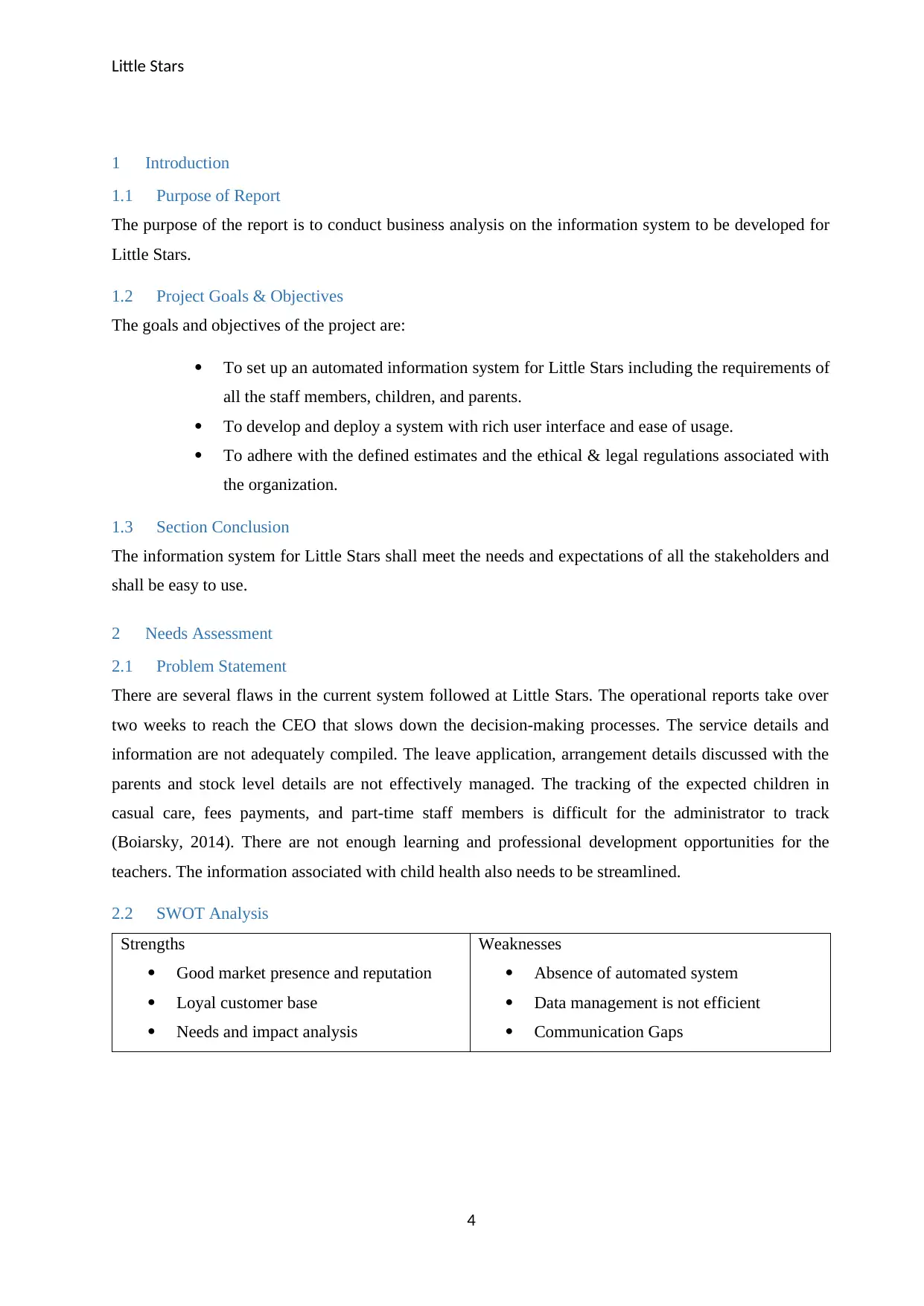
Little Stars
1 Introduction
1.1 Purpose of Report
The purpose of the report is to conduct business analysis on the information system to be developed for
Little Stars.
1.2 Project Goals & Objectives
The goals and objectives of the project are:
To set up an automated information system for Little Stars including the requirements of
all the staff members, children, and parents.
To develop and deploy a system with rich user interface and ease of usage.
To adhere with the defined estimates and the ethical & legal regulations associated with
the organization.
1.3 Section Conclusion
The information system for Little Stars shall meet the needs and expectations of all the stakeholders and
shall be easy to use.
2 Needs Assessment
2.1 Problem Statement
There are several flaws in the current system followed at Little Stars. The operational reports take over
two weeks to reach the CEO that slows down the decision-making processes. The service details and
information are not adequately compiled. The leave application, arrangement details discussed with the
parents and stock level details are not effectively managed. The tracking of the expected children in
casual care, fees payments, and part-time staff members is difficult for the administrator to track
(Boiarsky, 2014). There are not enough learning and professional development opportunities for the
teachers. The information associated with child health also needs to be streamlined.
2.2 SWOT Analysis
Strengths
Good market presence and reputation
Loyal customer base
Needs and impact analysis
Weaknesses
Absence of automated system
Data management is not efficient
Communication Gaps
4
1 Introduction
1.1 Purpose of Report
The purpose of the report is to conduct business analysis on the information system to be developed for
Little Stars.
1.2 Project Goals & Objectives
The goals and objectives of the project are:
To set up an automated information system for Little Stars including the requirements of
all the staff members, children, and parents.
To develop and deploy a system with rich user interface and ease of usage.
To adhere with the defined estimates and the ethical & legal regulations associated with
the organization.
1.3 Section Conclusion
The information system for Little Stars shall meet the needs and expectations of all the stakeholders and
shall be easy to use.
2 Needs Assessment
2.1 Problem Statement
There are several flaws in the current system followed at Little Stars. The operational reports take over
two weeks to reach the CEO that slows down the decision-making processes. The service details and
information are not adequately compiled. The leave application, arrangement details discussed with the
parents and stock level details are not effectively managed. The tracking of the expected children in
casual care, fees payments, and part-time staff members is difficult for the administrator to track
(Boiarsky, 2014). There are not enough learning and professional development opportunities for the
teachers. The information associated with child health also needs to be streamlined.
2.2 SWOT Analysis
Strengths
Good market presence and reputation
Loyal customer base
Needs and impact analysis
Weaknesses
Absence of automated system
Data management is not efficient
Communication Gaps
4
Paraphrase This Document
Need a fresh take? Get an instant paraphrase of this document with our AI Paraphraser
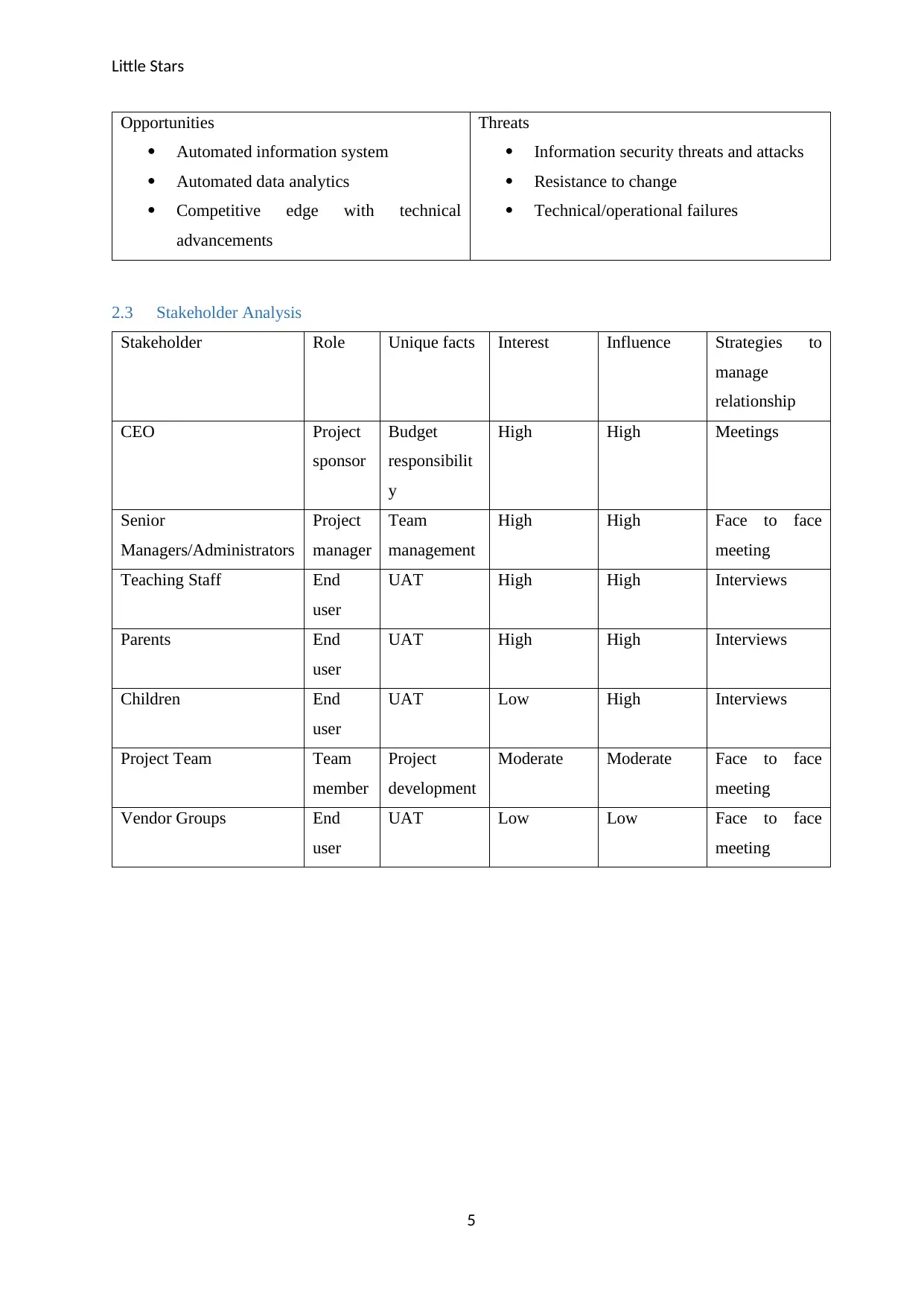
Little Stars
Opportunities
Automated information system
Automated data analytics
Competitive edge with technical
advancements
Threats
Information security threats and attacks
Resistance to change
Technical/operational failures
2.3 Stakeholder Analysis
Stakeholder Role Unique facts Interest Influence Strategies to
manage
relationship
CEO Project
sponsor
Budget
responsibilit
y
High High Meetings
Senior
Managers/Administrators
Project
manager
Team
management
High High Face to face
meeting
Teaching Staff End
user
UAT High High Interviews
Parents End
user
UAT High High Interviews
Children End
user
UAT Low High Interviews
Project Team Team
member
Project
development
Moderate Moderate Face to face
meeting
Vendor Groups End
user
UAT Low Low Face to face
meeting
5
Opportunities
Automated information system
Automated data analytics
Competitive edge with technical
advancements
Threats
Information security threats and attacks
Resistance to change
Technical/operational failures
2.3 Stakeholder Analysis
Stakeholder Role Unique facts Interest Influence Strategies to
manage
relationship
CEO Project
sponsor
Budget
responsibilit
y
High High Meetings
Senior
Managers/Administrators
Project
manager
Team
management
High High Face to face
meeting
Teaching Staff End
user
UAT High High Interviews
Parents End
user
UAT High High Interviews
Children End
user
UAT Low High Interviews
Project Team Team
member
Project
development
Moderate Moderate Face to face
meeting
Vendor Groups End
user
UAT Low Low Face to face
meeting
5
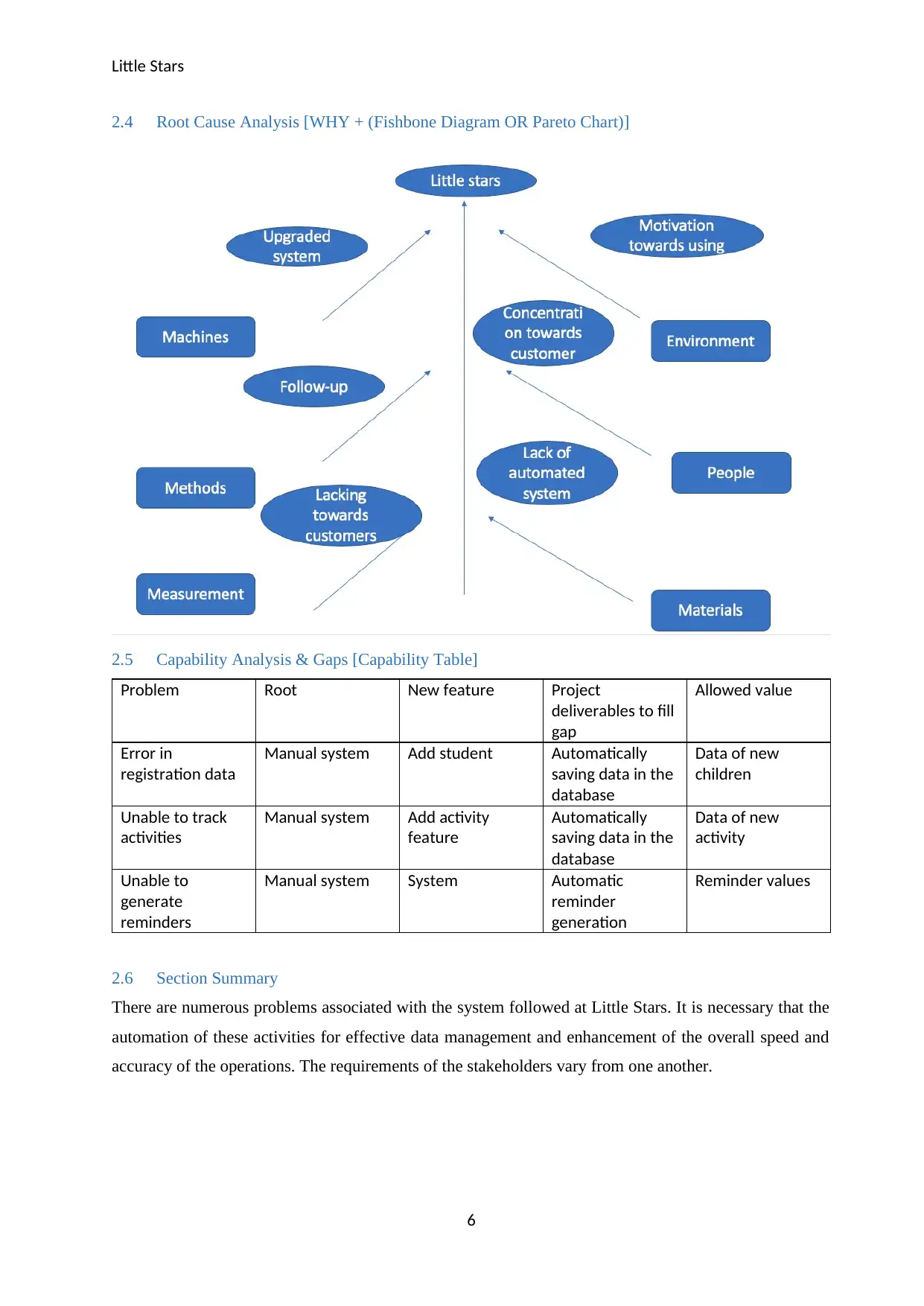
Little Stars
2.4 Root Cause Analysis [WHY + (Fishbone Diagram OR Pareto Chart)]
2.5 Capability Analysis & Gaps [Capability Table]
Problem Root New feature Project
deliverables to fill
gap
Allowed value
Error in
registration data
Manual system Add student Automatically
saving data in the
database
Data of new
children
Unable to track
activities
Manual system Add activity
feature
Automatically
saving data in the
database
Data of new
activity
Unable to
generate
reminders
Manual system System Automatic
reminder
generation
Reminder values
2.6 Section Summary
There are numerous problems associated with the system followed at Little Stars. It is necessary that the
automation of these activities for effective data management and enhancement of the overall speed and
accuracy of the operations. The requirements of the stakeholders vary from one another.
6
2.4 Root Cause Analysis [WHY + (Fishbone Diagram OR Pareto Chart)]
2.5 Capability Analysis & Gaps [Capability Table]
Problem Root New feature Project
deliverables to fill
gap
Allowed value
Error in
registration data
Manual system Add student Automatically
saving data in the
database
Data of new
children
Unable to track
activities
Manual system Add activity
feature
Automatically
saving data in the
database
Data of new
activity
Unable to
generate
reminders
Manual system System Automatic
reminder
generation
Reminder values
2.6 Section Summary
There are numerous problems associated with the system followed at Little Stars. It is necessary that the
automation of these activities for effective data management and enhancement of the overall speed and
accuracy of the operations. The requirements of the stakeholders vary from one another.
6
⊘ This is a preview!⊘
Do you want full access?
Subscribe today to unlock all pages.

Trusted by 1+ million students worldwide
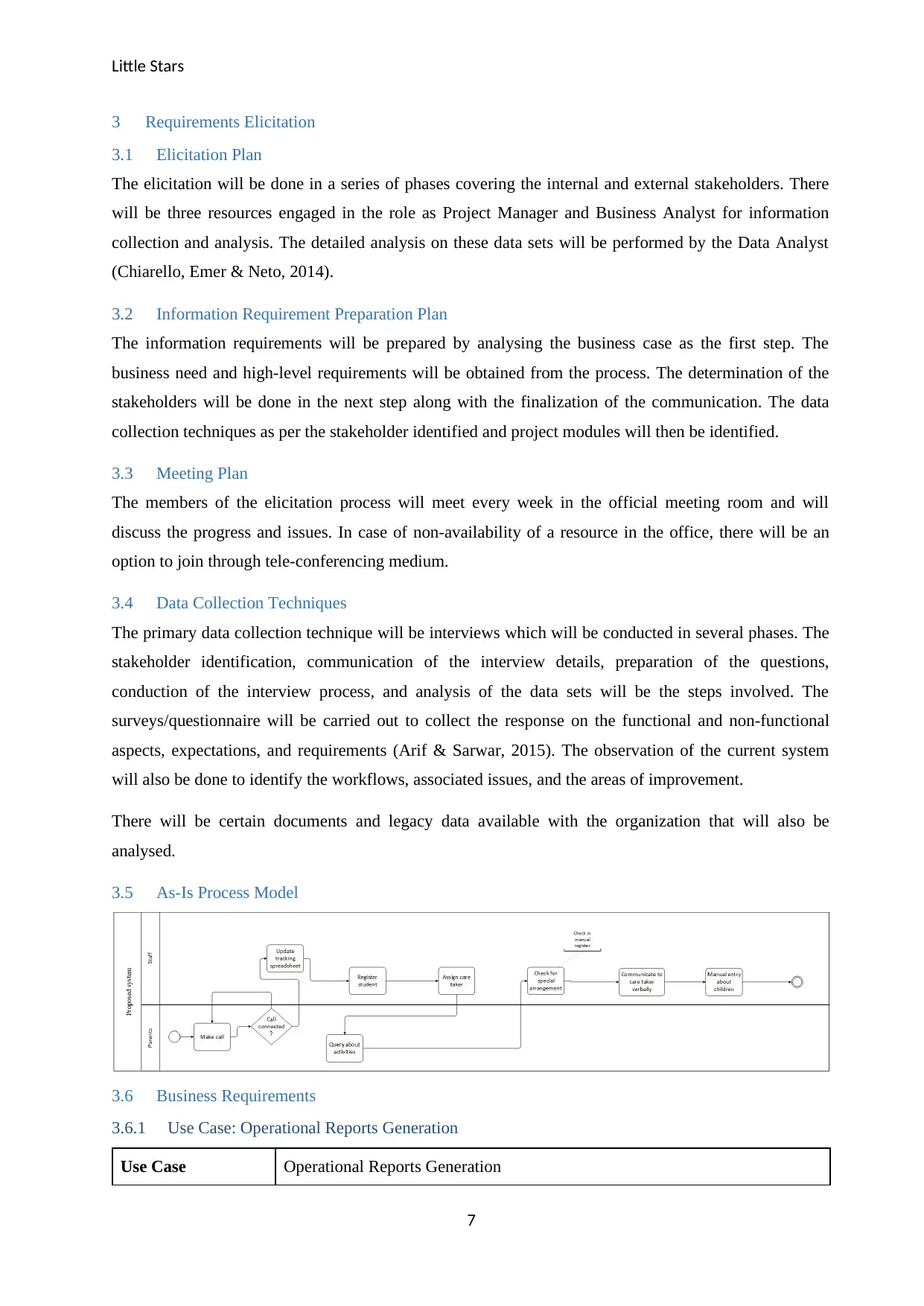
Little Stars
3 Requirements Elicitation
3.1 Elicitation Plan
The elicitation will be done in a series of phases covering the internal and external stakeholders. There
will be three resources engaged in the role as Project Manager and Business Analyst for information
collection and analysis. The detailed analysis on these data sets will be performed by the Data Analyst
(Chiarello, Emer & Neto, 2014).
3.2 Information Requirement Preparation Plan
The information requirements will be prepared by analysing the business case as the first step. The
business need and high-level requirements will be obtained from the process. The determination of the
stakeholders will be done in the next step along with the finalization of the communication. The data
collection techniques as per the stakeholder identified and project modules will then be identified.
3.3 Meeting Plan
The members of the elicitation process will meet every week in the official meeting room and will
discuss the progress and issues. In case of non-availability of a resource in the office, there will be an
option to join through tele-conferencing medium.
3.4 Data Collection Techniques
The primary data collection technique will be interviews which will be conducted in several phases. The
stakeholder identification, communication of the interview details, preparation of the questions,
conduction of the interview process, and analysis of the data sets will be the steps involved. The
surveys/questionnaire will be carried out to collect the response on the functional and non-functional
aspects, expectations, and requirements (Arif & Sarwar, 2015). The observation of the current system
will also be done to identify the workflows, associated issues, and the areas of improvement.
There will be certain documents and legacy data available with the organization that will also be
analysed.
3.5 As-Is Process Model
3.6 Business Requirements
3.6.1 Use Case: Operational Reports Generation
Use Case Operational Reports Generation
7
3 Requirements Elicitation
3.1 Elicitation Plan
The elicitation will be done in a series of phases covering the internal and external stakeholders. There
will be three resources engaged in the role as Project Manager and Business Analyst for information
collection and analysis. The detailed analysis on these data sets will be performed by the Data Analyst
(Chiarello, Emer & Neto, 2014).
3.2 Information Requirement Preparation Plan
The information requirements will be prepared by analysing the business case as the first step. The
business need and high-level requirements will be obtained from the process. The determination of the
stakeholders will be done in the next step along with the finalization of the communication. The data
collection techniques as per the stakeholder identified and project modules will then be identified.
3.3 Meeting Plan
The members of the elicitation process will meet every week in the official meeting room and will
discuss the progress and issues. In case of non-availability of a resource in the office, there will be an
option to join through tele-conferencing medium.
3.4 Data Collection Techniques
The primary data collection technique will be interviews which will be conducted in several phases. The
stakeholder identification, communication of the interview details, preparation of the questions,
conduction of the interview process, and analysis of the data sets will be the steps involved. The
surveys/questionnaire will be carried out to collect the response on the functional and non-functional
aspects, expectations, and requirements (Arif & Sarwar, 2015). The observation of the current system
will also be done to identify the workflows, associated issues, and the areas of improvement.
There will be certain documents and legacy data available with the organization that will also be
analysed.
3.5 As-Is Process Model
3.6 Business Requirements
3.6.1 Use Case: Operational Reports Generation
Use Case Operational Reports Generation
7
Paraphrase This Document
Need a fresh take? Get an instant paraphrase of this document with our AI Paraphraser
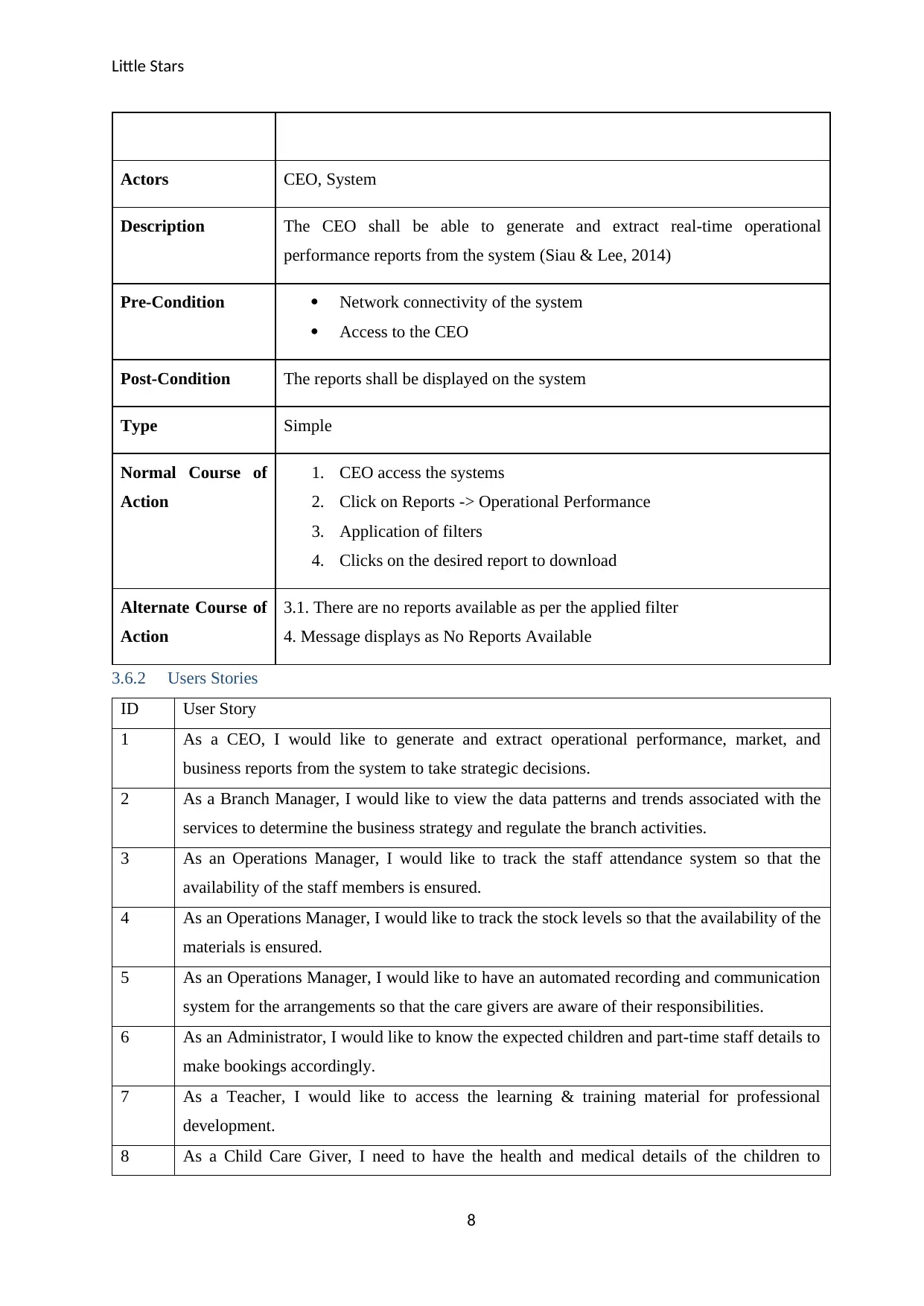
Little Stars
Actors CEO, System
Description The CEO shall be able to generate and extract real-time operational
performance reports from the system (Siau & Lee, 2014)
Pre-Condition Network connectivity of the system
Access to the CEO
Post-Condition The reports shall be displayed on the system
Type Simple
Normal Course of
Action
1. CEO access the systems
2. Click on Reports -> Operational Performance
3. Application of filters
4. Clicks on the desired report to download
Alternate Course of
Action
3.1. There are no reports available as per the applied filter
4. Message displays as No Reports Available
3.6.2 Users Stories
ID User Story
1 As a CEO, I would like to generate and extract operational performance, market, and
business reports from the system to take strategic decisions.
2 As a Branch Manager, I would like to view the data patterns and trends associated with the
services to determine the business strategy and regulate the branch activities.
3 As an Operations Manager, I would like to track the staff attendance system so that the
availability of the staff members is ensured.
4 As an Operations Manager, I would like to track the stock levels so that the availability of the
materials is ensured.
5 As an Operations Manager, I would like to have an automated recording and communication
system for the arrangements so that the care givers are aware of their responsibilities.
6 As an Administrator, I would like to know the expected children and part-time staff details to
make bookings accordingly.
7 As a Teacher, I would like to access the learning & training material for professional
development.
8 As a Child Care Giver, I need to have the health and medical details of the children to
8
Actors CEO, System
Description The CEO shall be able to generate and extract real-time operational
performance reports from the system (Siau & Lee, 2014)
Pre-Condition Network connectivity of the system
Access to the CEO
Post-Condition The reports shall be displayed on the system
Type Simple
Normal Course of
Action
1. CEO access the systems
2. Click on Reports -> Operational Performance
3. Application of filters
4. Clicks on the desired report to download
Alternate Course of
Action
3.1. There are no reports available as per the applied filter
4. Message displays as No Reports Available
3.6.2 Users Stories
ID User Story
1 As a CEO, I would like to generate and extract operational performance, market, and
business reports from the system to take strategic decisions.
2 As a Branch Manager, I would like to view the data patterns and trends associated with the
services to determine the business strategy and regulate the branch activities.
3 As an Operations Manager, I would like to track the staff attendance system so that the
availability of the staff members is ensured.
4 As an Operations Manager, I would like to track the stock levels so that the availability of the
materials is ensured.
5 As an Operations Manager, I would like to have an automated recording and communication
system for the arrangements so that the care givers are aware of their responsibilities.
6 As an Administrator, I would like to know the expected children and part-time staff details to
make bookings accordingly.
7 As a Teacher, I would like to access the learning & training material for professional
development.
8 As a Child Care Giver, I need to have the health and medical details of the children to
8
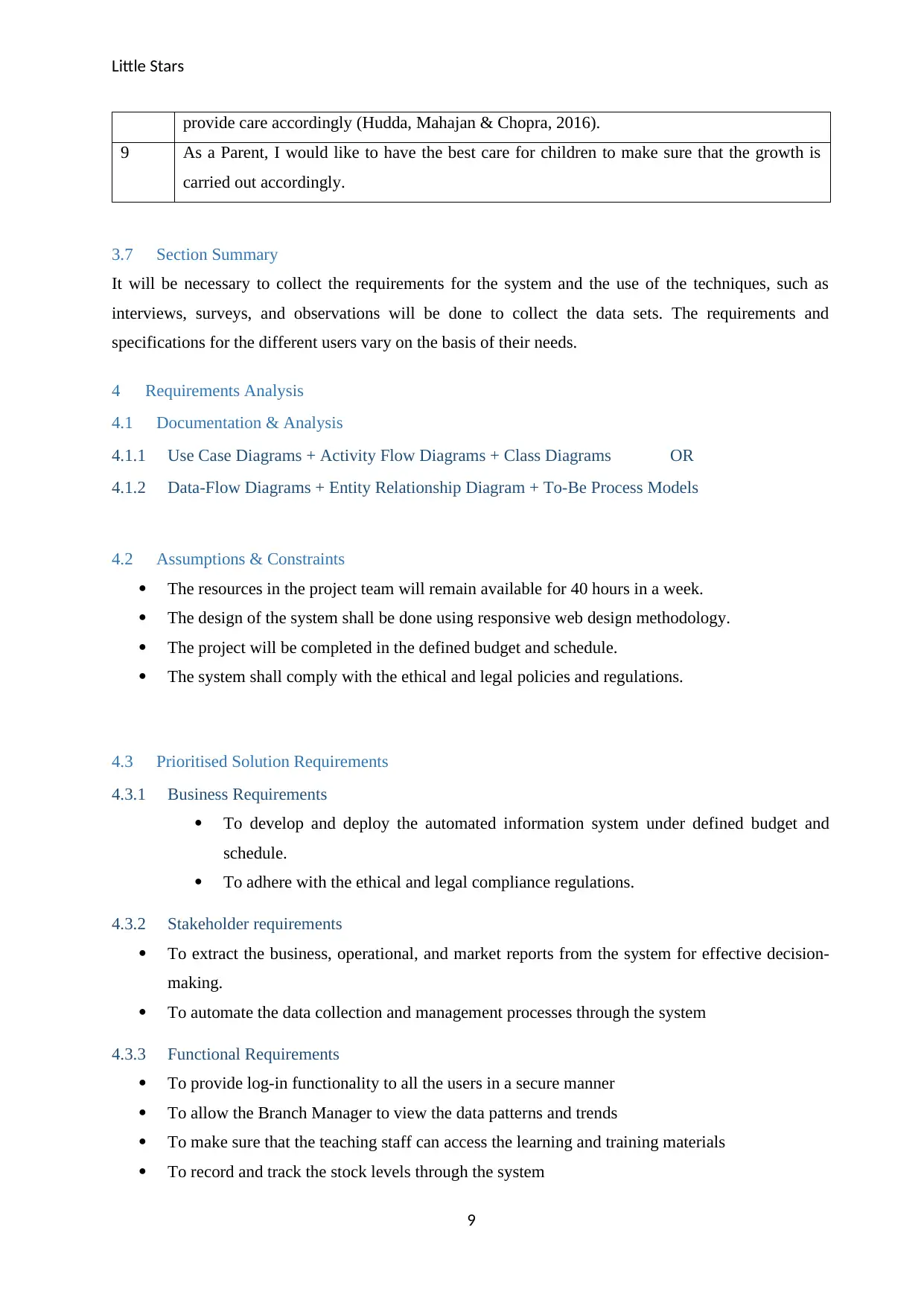
Little Stars
provide care accordingly (Hudda, Mahajan & Chopra, 2016).
9 As a Parent, I would like to have the best care for children to make sure that the growth is
carried out accordingly.
3.7 Section Summary
It will be necessary to collect the requirements for the system and the use of the techniques, such as
interviews, surveys, and observations will be done to collect the data sets. The requirements and
specifications for the different users vary on the basis of their needs.
4 Requirements Analysis
4.1 Documentation & Analysis
4.1.1 Use Case Diagrams + Activity Flow Diagrams + Class Diagrams OR
4.1.2 Data-Flow Diagrams + Entity Relationship Diagram + To-Be Process Models
4.2 Assumptions & Constraints
The resources in the project team will remain available for 40 hours in a week.
The design of the system shall be done using responsive web design methodology.
The project will be completed in the defined budget and schedule.
The system shall comply with the ethical and legal policies and regulations.
4.3 Prioritised Solution Requirements
4.3.1 Business Requirements
To develop and deploy the automated information system under defined budget and
schedule.
To adhere with the ethical and legal compliance regulations.
4.3.2 Stakeholder requirements
To extract the business, operational, and market reports from the system for effective decision-
making.
To automate the data collection and management processes through the system
4.3.3 Functional Requirements
To provide log-in functionality to all the users in a secure manner
To allow the Branch Manager to view the data patterns and trends
To make sure that the teaching staff can access the learning and training materials
To record and track the stock levels through the system
9
provide care accordingly (Hudda, Mahajan & Chopra, 2016).
9 As a Parent, I would like to have the best care for children to make sure that the growth is
carried out accordingly.
3.7 Section Summary
It will be necessary to collect the requirements for the system and the use of the techniques, such as
interviews, surveys, and observations will be done to collect the data sets. The requirements and
specifications for the different users vary on the basis of their needs.
4 Requirements Analysis
4.1 Documentation & Analysis
4.1.1 Use Case Diagrams + Activity Flow Diagrams + Class Diagrams OR
4.1.2 Data-Flow Diagrams + Entity Relationship Diagram + To-Be Process Models
4.2 Assumptions & Constraints
The resources in the project team will remain available for 40 hours in a week.
The design of the system shall be done using responsive web design methodology.
The project will be completed in the defined budget and schedule.
The system shall comply with the ethical and legal policies and regulations.
4.3 Prioritised Solution Requirements
4.3.1 Business Requirements
To develop and deploy the automated information system under defined budget and
schedule.
To adhere with the ethical and legal compliance regulations.
4.3.2 Stakeholder requirements
To extract the business, operational, and market reports from the system for effective decision-
making.
To automate the data collection and management processes through the system
4.3.3 Functional Requirements
To provide log-in functionality to all the users in a secure manner
To allow the Branch Manager to view the data patterns and trends
To make sure that the teaching staff can access the learning and training materials
To record and track the stock levels through the system
9
⊘ This is a preview!⊘
Do you want full access?
Subscribe today to unlock all pages.

Trusted by 1+ million students worldwide
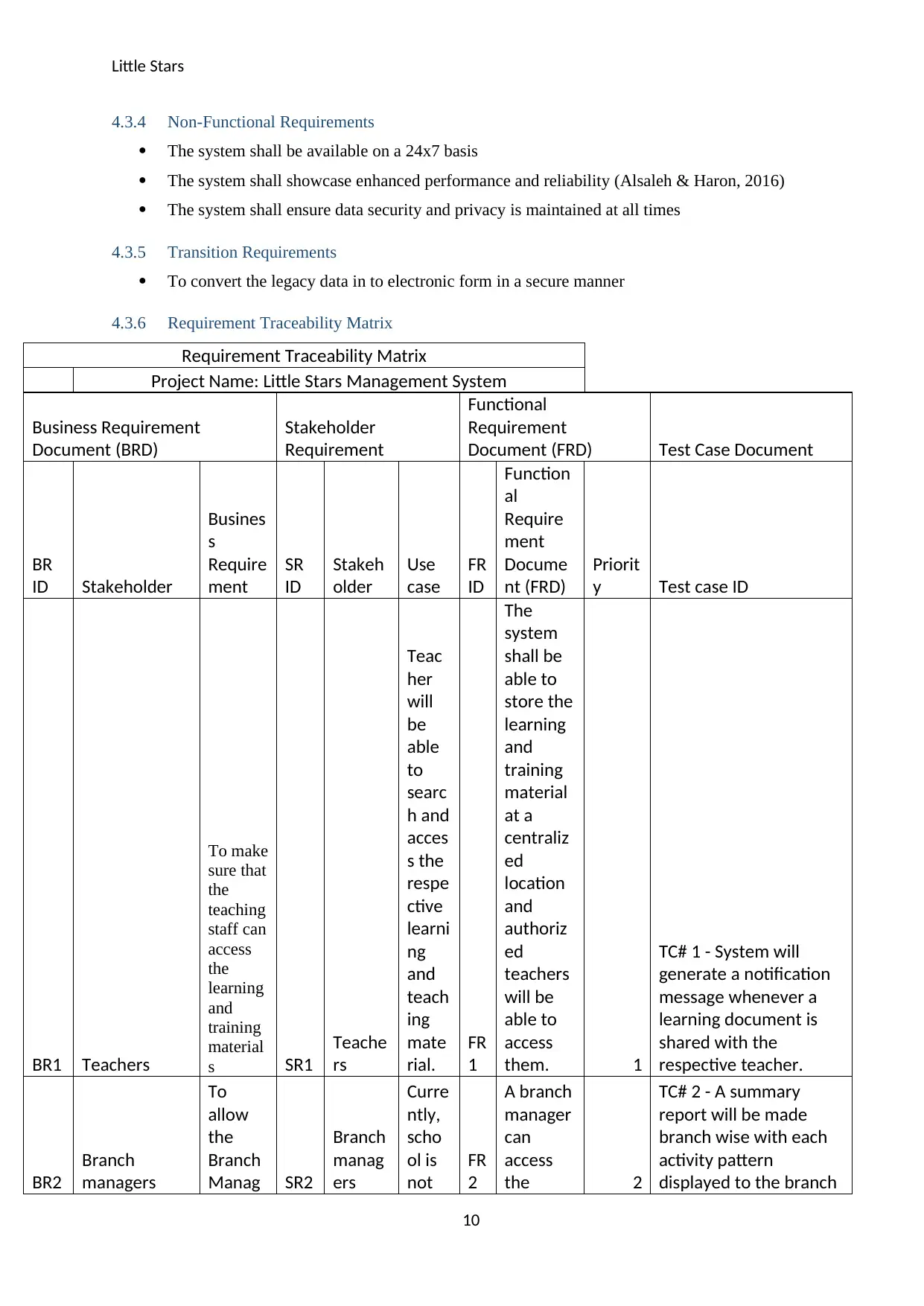
Little Stars
4.3.4 Non-Functional Requirements
The system shall be available on a 24x7 basis
The system shall showcase enhanced performance and reliability (Alsaleh & Haron, 2016)
The system shall ensure data security and privacy is maintained at all times
4.3.5 Transition Requirements
To convert the legacy data in to electronic form in a secure manner
4.3.6 Requirement Traceability Matrix
Requirement Traceability Matrix
Project Name: Little Stars Management System
Business Requirement
Document (BRD)
Stakeholder
Requirement
Functional
Requirement
Document (FRD) Test Case Document
BR
ID Stakeholder
Busines
s
Require
ment
SR
ID
Stakeh
older
Use
case
FR
ID
Function
al
Require
ment
Docume
nt (FRD)
Priorit
y Test case ID
BR1 Teachers
To make
sure that
the
teaching
staff can
access
the
learning
and
training
material
s SR1
Teache
rs
Teac
her
will
be
able
to
searc
h and
acces
s the
respe
ctive
learni
ng
and
teach
ing
mate
rial.
FR
1
The
system
shall be
able to
store the
learning
and
training
material
at a
centraliz
ed
location
and
authoriz
ed
teachers
will be
able to
access
them. 1
TC# 1 - System will
generate a notification
message whenever a
learning document is
shared with the
respective teacher.
BR2
Branch
managers
To
allow
the
Branch
Manag SR2
Branch
manag
ers
Curre
ntly,
scho
ol is
not
FR
2
A branch
manager
can
access
the 2
TC# 2 - A summary
report will be made
branch wise with each
activity pattern
displayed to the branch
10
4.3.4 Non-Functional Requirements
The system shall be available on a 24x7 basis
The system shall showcase enhanced performance and reliability (Alsaleh & Haron, 2016)
The system shall ensure data security and privacy is maintained at all times
4.3.5 Transition Requirements
To convert the legacy data in to electronic form in a secure manner
4.3.6 Requirement Traceability Matrix
Requirement Traceability Matrix
Project Name: Little Stars Management System
Business Requirement
Document (BRD)
Stakeholder
Requirement
Functional
Requirement
Document (FRD) Test Case Document
BR
ID Stakeholder
Busines
s
Require
ment
SR
ID
Stakeh
older
Use
case
FR
ID
Function
al
Require
ment
Docume
nt (FRD)
Priorit
y Test case ID
BR1 Teachers
To make
sure that
the
teaching
staff can
access
the
learning
and
training
material
s SR1
Teache
rs
Teac
her
will
be
able
to
searc
h and
acces
s the
respe
ctive
learni
ng
and
teach
ing
mate
rial.
FR
1
The
system
shall be
able to
store the
learning
and
training
material
at a
centraliz
ed
location
and
authoriz
ed
teachers
will be
able to
access
them. 1
TC# 1 - System will
generate a notification
message whenever a
learning document is
shared with the
respective teacher.
BR2
Branch
managers
To
allow
the
Branch
Manag SR2
Branch
manag
ers
Curre
ntly,
scho
ol is
not
FR
2
A branch
manager
can
access
the 2
TC# 2 - A summary
report will be made
branch wise with each
activity pattern
displayed to the branch
10
Paraphrase This Document
Need a fresh take? Get an instant paraphrase of this document with our AI Paraphraser
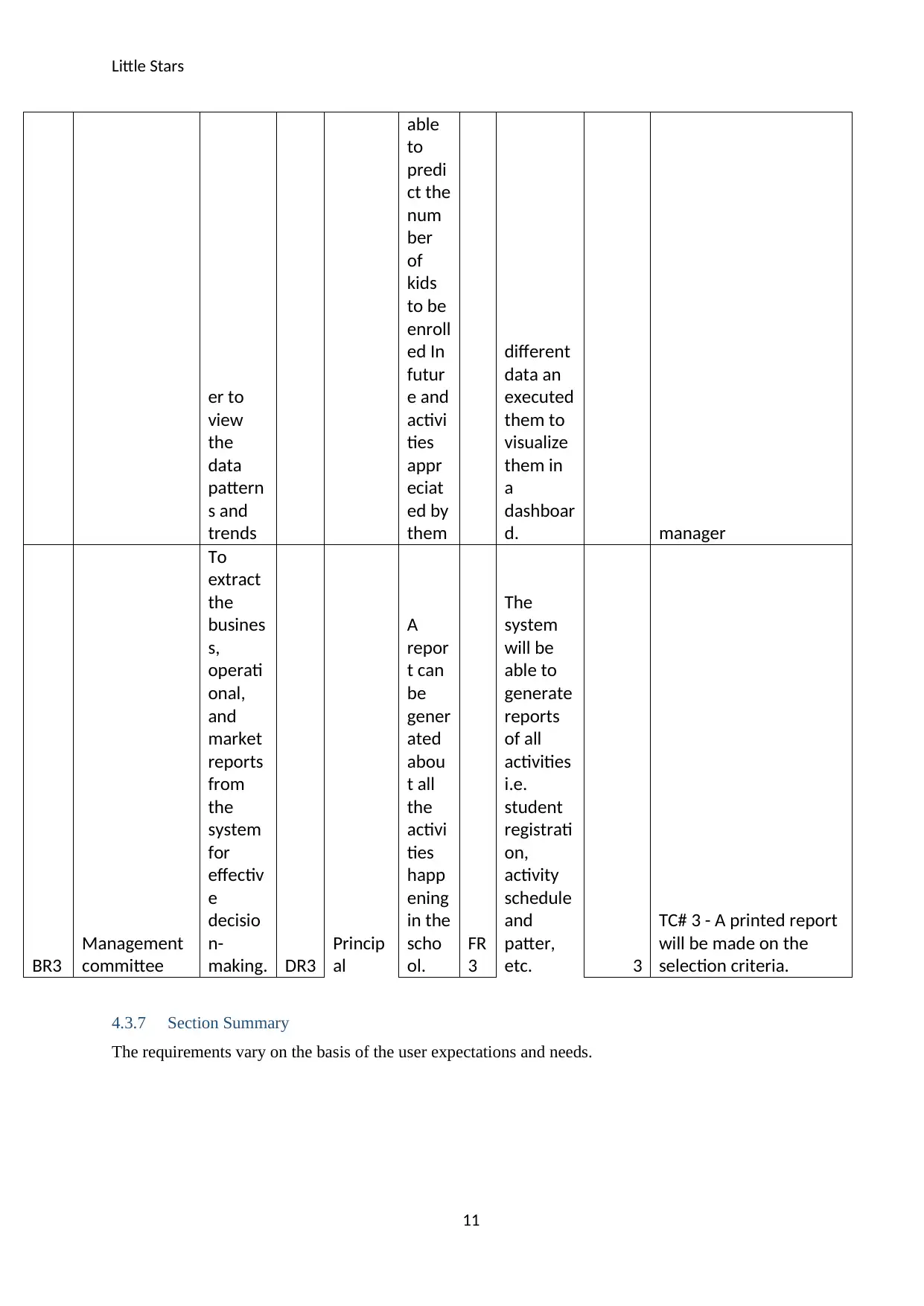
Little Stars
er to
view
the
data
pattern
s and
trends
able
to
predi
ct the
num
ber
of
kids
to be
enroll
ed In
futur
e and
activi
ties
appr
eciat
ed by
them
different
data an
executed
them to
visualize
them in
a
dashboar
d. manager
BR3
Management
committee
To
extract
the
busines
s,
operati
onal,
and
market
reports
from
the
system
for
effectiv
e
decisio
n-
making. DR3
Princip
al
A
repor
t can
be
gener
ated
abou
t all
the
activi
ties
happ
ening
in the
scho
ol.
FR
3
The
system
will be
able to
generate
reports
of all
activities
i.e.
student
registrati
on,
activity
schedule
and
patter,
etc. 3
TC# 3 - A printed report
will be made on the
selection criteria.
4.3.7 Section Summary
The requirements vary on the basis of the user expectations and needs.
11
er to
view
the
data
pattern
s and
trends
able
to
predi
ct the
num
ber
of
kids
to be
enroll
ed In
futur
e and
activi
ties
appr
eciat
ed by
them
different
data an
executed
them to
visualize
them in
a
dashboar
d. manager
BR3
Management
committee
To
extract
the
busines
s,
operati
onal,
and
market
reports
from
the
system
for
effectiv
e
decisio
n-
making. DR3
Princip
al
A
repor
t can
be
gener
ated
abou
t all
the
activi
ties
happ
ening
in the
scho
ol.
FR
3
The
system
will be
able to
generate
reports
of all
activities
i.e.
student
registrati
on,
activity
schedule
and
patter,
etc. 3
TC# 3 - A printed report
will be made on the
selection criteria.
4.3.7 Section Summary
The requirements vary on the basis of the user expectations and needs.
11
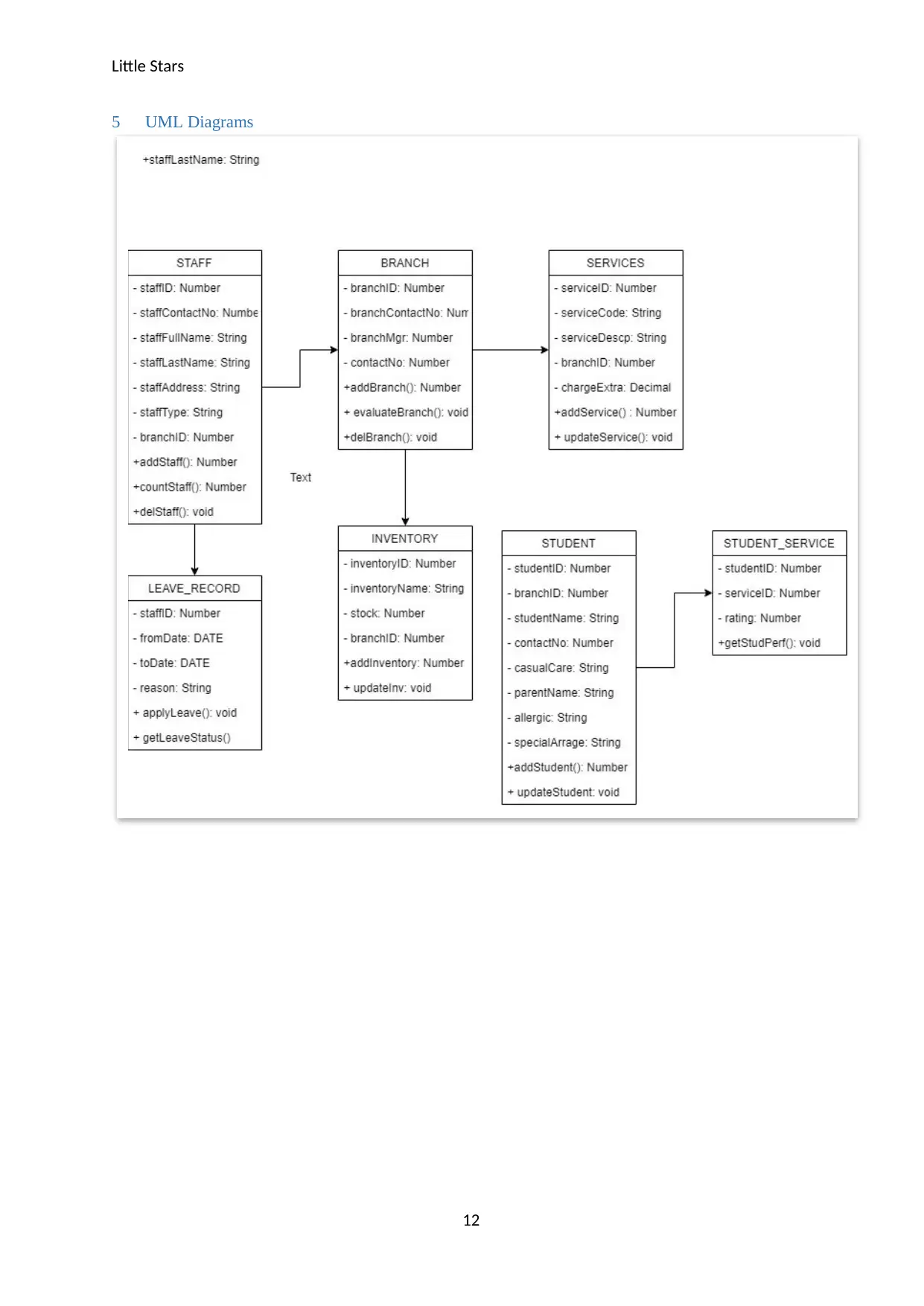
Little Stars
5 UML Diagrams
12
5 UML Diagrams
12
⊘ This is a preview!⊘
Do you want full access?
Subscribe today to unlock all pages.

Trusted by 1+ million students worldwide
1 out of 15
Related Documents
Your All-in-One AI-Powered Toolkit for Academic Success.
+13062052269
info@desklib.com
Available 24*7 on WhatsApp / Email
![[object Object]](/_next/static/media/star-bottom.7253800d.svg)
Unlock your academic potential
Copyright © 2020–2025 A2Z Services. All Rights Reserved. Developed and managed by ZUCOL.





